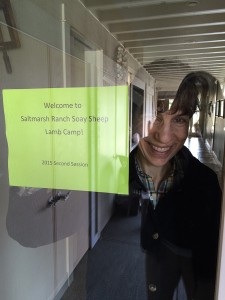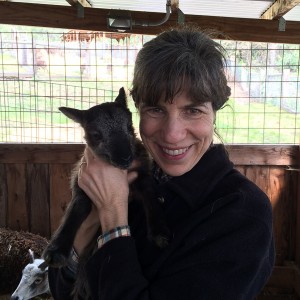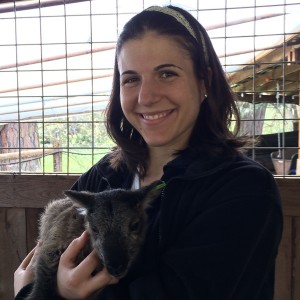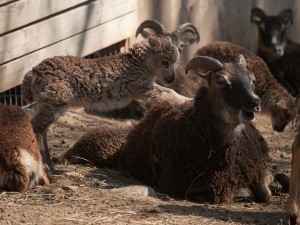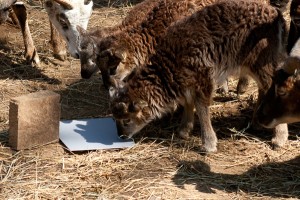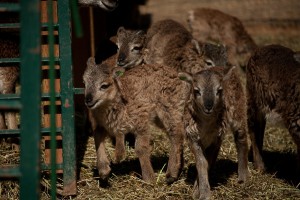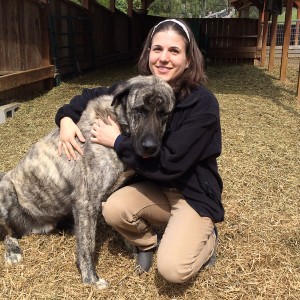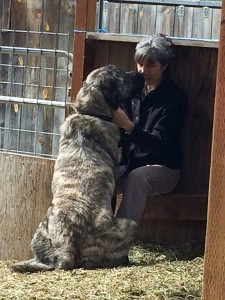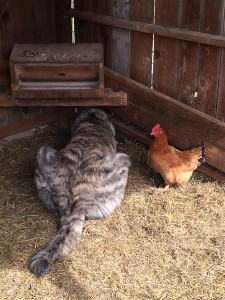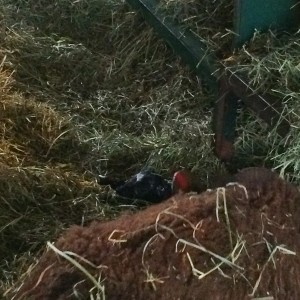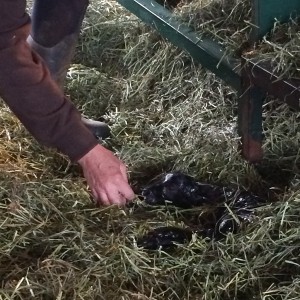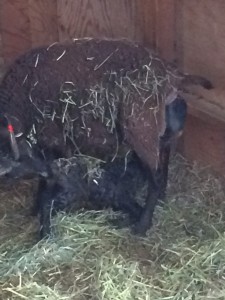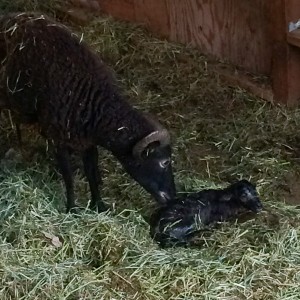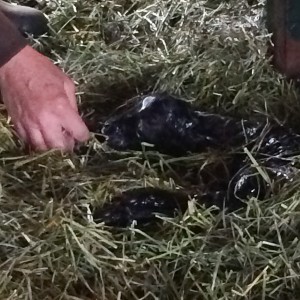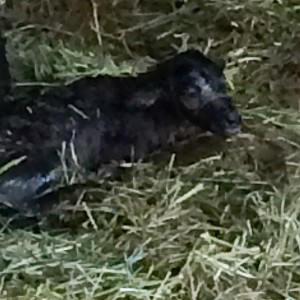Lamb Camp Day 1: Campers arrive and so do their first lambs
Our friend Ida had so much fun visiting us during lambing in 2013 that she applied to return this year. In my last post, I tried to set the stage for Lamb Camp 2015 by sharing the backstory of Ida’s first visit. By the time Ida and daughter Whitney and niece Audrey arrived on April 10, 2015, we already had 17 new lambs frolicking in their spring play yard and 17 pregnant ewes still in the Maternity Ward bursting at their wooly seams with lambs. Not much happened the first day in the category of Serious Soay Husbandry, but it was a lot of fun and pretty typical of downtime during lambing on our farm.
First light on April 10, 2015, the promise of a warm sunny spring day, the lamb play yard and the Maternity Ward teeming with new life, born and almost-born. Steve stayed on the farm for a vet visit to check our biggest dog Alfie’s ear after a nasty winter infection while I drove to the airport to pick up our first two Campers — Ida and Whitney. After a quick spin through Jacksonville so they could check on their Britt Classical Music Festival home-away-from-home, we got them settled in their rooms (way better, if I do say so, than the bunkhouses of my childhood church camp experiences), allocated muck shoes from our motley collection, and headed over to the Maternity Ward.
For most of the afternoon, there were no new lambs, no action from any of the pregnant ewes, and no lamb crises. Time to improvise while we waited for lambs: nuzzle the existing lambs and watch the oldest lambs (born the last week in March) play. Newsflash for heritage sheep breeders: your lambs are irresistible to adults, never mind to children. I submit these photos of Senior Camper Ida and First-time Camper Whitney as proof.
A person can easily sit in a discarded lawn chair in the lamb play yard watching the lambs, and that’s just fine. We do it for hours on end during lambing.
But Ida and Whitney come from a family of Big Dog owners, and before long they turned from watching the lambs frolic to making friends with our biggest Big Dog, Alfie (officially Alfred Brindl but that’s another post for another time). Remember the Scarecrow in the Wizard of Oz? Brainless, he “whiled away the hours conferrin’ with the flowers and consultin’ with the rain.” I can assure you Ida and Whitney have brains, and worthy ones at that. Nonetheless, they managed to while away a goodly portion of the afternoon consulting with Alfie.
By about 4:00, one pregnant ewe, Darby, finally got restless and started acting as though she might lamb, so Ida and Whitney left the play yard to watch the ewe in the Maternity Ward.
No sooner did they turn their back on Alfie than he snuck over to the mineral feeder, which our chickens use as a roof over their favorite nesting spot, and proceeded to steal their newly-laid eggs. Whitney spoiled his fun by recording the miscreant on her iPhone.
For those of you who long for substance in this post, here’s some. Joel Salatin and a lot of other farmers have been saying for a long time that livestock breeders should keep chickens with their animals to eat fly larva and the parasites the livestock shed, and that it’s a good way to cut down on the need for chemical wormers. We didn’t believe it until we tried it, but now we keep chickens with each pasture of sheep for at least part of the year. Not only do we have awesome eggs with rich, dark orange yolks. We we also have almost no flies in the lamb play yard (where there is ample manure for them to hatch in) and we are pretty sure the chickens are making a noticeable dent in our adult sheep’s worm load. Okay, enough with the serious stuff.
One of the things about my childhood that continues to come in handy during lambing, and that served me well on the first day of Lamb Camp, is the circumstance that in my family, there was no such thing as a set time for dinner, or anything remotely close. That’s because my dad was a large animal veterinarian and his busiest time of day often was late afternoon when the farmers came in from the cornfields in Iowa and checked on their animals before supper. So I never assume we will be back in the house for dinner during lambing at a set time.
Sure enough, Darby fussed around until about 6:00 pm, when her water finally broke and she spent the next hour making her nest by pawing in the straw and dirt in the Maternity Ward, with Ida, Whitney and Steve looking on. I went back to the house to start dinner, all the while receiving blow-by-blow updates on my walkie talkie:
“She is getting down to business.” “A nose and hooves are showing.”
Brief pause for another husbandry note: we almost never get close to a ewe or her newborn lamb until the lamb is up and about and has had its first meal of colostrum. The ewe must lick off her baby to stimulate it to stand up, and the birth fluids are said to contain substances, most likely hormones, that trigger the ewe’s milk to come down so she can nurse. And besides, the last thing we want to do is interfere with the critical first few minutes’ of bonding. One exception to this rule is making sure the lamb has started to breathe on its own once the umbilical cord breaks. Almost always the lamb starts breathing completely on its own within 15 seconds to a couple of minutes, or the mother licks off the birth sac covering its nose and the lamb responds to the stimulation by shaking its head, crying, or at least working its lungs. But perhaps once a year, every 30-40 lambs (i.e., very very rarely) a lamb shows no signs of breathing for so long (2 minutes by a watch, perhaps) that we worry about asphyxiation. Almost always the lamb will shake its head, even feebly, or light glints off its little ribcage and we see movement there, or most often the lamb is much more vigorous about getting air. When we see no movement for too long, one of us will quietly slip in to the birthing area, and quickly swipe its nose with a clean rough towel and put a piece of straw up its nose for just an instant. The itchy feeling makes the lamb shake its head and protest… and thus breathe.
Where was I? Oh yes, Darby. In the next picture, you will see an example of what we call The Multi-tasking Ewe. She has successfully cleaned off her first lamb and he is on the way to her udder to eat just when the second lamb announces it is ready to arrive as well. Wow.
One last husbandry note before I get to the always-important subject of dinner menus. To illustrate the point about getting a seemingly-comatose lamb to breathe, I have zeroed in on Darby’s first and second lambs’ faces right when they hit the ground. The quality of the pictures is not very good, but I think you’ll be able to see the difference and why Steve decided he needed to provoke the first lamb, but not the second one. Here goes:
Because Darby’s ram lamb was the first Soay sheep birth Whitney witnessed, she got to name him. For reasons I will explain some other time, our naming theme this year is small towns in the English county of Buckinghamshire. Whitney decided the lamb is a rock star and that “Redland” sounded important and tough, so “Saltmarsh Redland” it is for this lamb, OR119-713.
Oh, and did I mention that Redland is enormous? I haven’t had time to run the numbers, but as best Steve and I can recall from memory, our average twin size in past years has been four pounds and a few ounces. Redland weighed in two and a half hours after he was born at a whopping 6 pounds 8 ounces, by far our biggest twin ever by a wide margin, and bigger than most of the singles we’ve had. If I ever have time to write a post about the larger lambs we are getting in general, I’ll come back here and link to it.
With Ida and Whitney happily chattering in the kitchen about their first day of camp activities, I put together quite a tasty pasta dish using a timely and much-appreciated gift of a whole bag of morel mushrooms from a neighbor’s secret cache, stir-fried greens (onion, Balti seasoning, tangerine, cherries), and simple black cod filets to top the linguini. Ida and I took a quick nap from 8-10 while Steve and Whitney worked the twins. At 10:15 Ida and I headed to airport while Steve and Whitney collapsed after a long day. Audrey’s plane arrived at 12:30 a.m., we got home and did a quick lamb check at 1:20 a.m., with Audrey getting her first look at the ewes and lambs in the jugs in pitch dark broken by flashlights. All was peaceful, calm, and sleepy.
As I know, but you don’t at this point, the second day of Lamb Camp brought lots of new adventures, more lambs, and more evidence of the joys of raising Soay sheep. Stay tuned.
For now …
